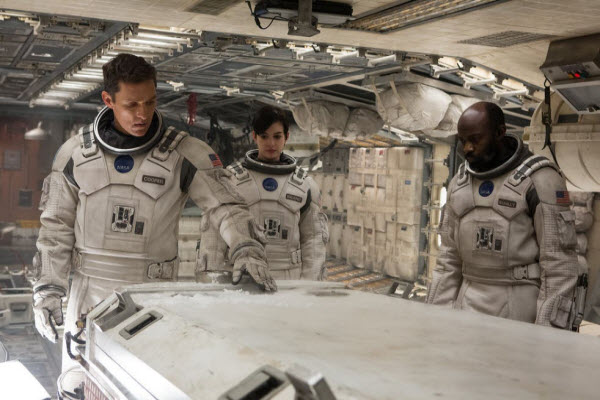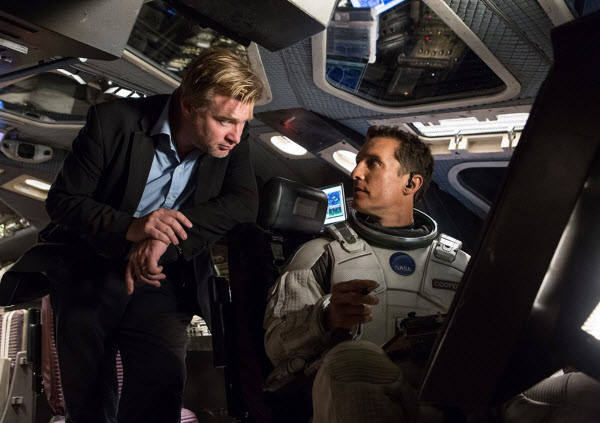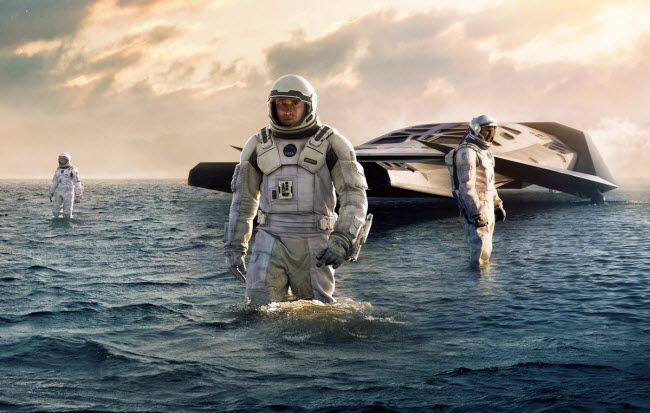Interstellar is a groundbreaking film that pushes the boundaries of science fiction, blending scientific theory with a profound exploration of human emotions and survival. Directed by Christopher Nolan and released in 2014, this cinematic masterpiece takes audiences on a visually stunning journey through space and time, delving into themes of love, sacrifice, and humanity’s survival. With its innovative narrative, dazzling visual effects, and challenging script, Interstellar has become a modern classic in the science fiction genre.
Plot Summary (Warning: Spoilers Ahead)

Interstellar unfolds in two compelling parts, focusing on a team of astronauts traveling through a wormhole in search of a new habitable planet for humanity. The story begins on a dystopian Earth, ravaged by environmental collapse and food shortages. Cooper (Matthew McConaughey), a former NASA pilot, is recruited for a mission to save humanity. He and his team, including Dr. Amelia Brand (Anne Hathaway), traverse a wormhole near Saturn to explore potential planets for human habitation.
The film juxtaposes space exploration with the emotional journey of Cooper’s daughter, Murph (Jessica Chastain), who remains on Earth. As Cooper and his team face various challenges in space, including time dilation near a massive black hole, Murph makes significant scientific discoveries on Earth, eventually finding a way to manipulate gravity and save humanity.
The narrative intertwines the astronauts’ struggles with Murph’s efforts to solve the equation necessary for humanity’s survival. The film reaches its emotional climax when Cooper sacrifices himself to send vital data back to Earth, leading to Murph’s successful resolution of the gravity problem and the eventual salvation of humanity from the dying planet.
Main Characters and Actors
- Cooper (Matthew McConaughey): A former NASA pilot and engineer who leads the mission to find a new home for humanity.
- Dr. Amelia Brand (Anne Hathaway): A scientist and NASA astronaut who joins Cooper on the interstellar journey.
- Murph (Jessica Chastain): Cooper’s daughter, who becomes a key scientist in solving the equation to save humanity.
- Dr. Brand (Michael Caine): A NASA physicist and Murph’s father, playing a crucial role in the mission.
- TARS (voice by Bill Irwin): A highly intelligent robot that assists the astronauts in various tasks.
Awards and Recognition
Interstellar was both a critical and commercial success, receiving several accolades and nominations. It was praised for its ambition, innovative visual effects, and emotional depth. The film won the Oscar for Best Visual Effects and was nominated for Best Original Score, Best Production Design, and Best Sound Mixing. The film’s evocative score by Hans Zimmer and its groundbreaking visual effects were particularly notable for their contribution to the film’s impact.
Trivia (100 Interesting Facts)

- Black Hole Accuracy: The depiction of the black hole, Gargantua, in the film was based on scientific research conducted by physicist Kip Thorne.
- Realistic Science: Kip Thorne served as a scientific advisor to ensure that the film’s scientific concepts were as accurate as possible.
- Time Dilation: The film explores the concept of time dilation, where time passes more slowly in strong gravitational fields.
- Rotating Space Station: The design of the space station in the film was inspired by real-life concepts for space habitation.
- Interstellar Music: Hans Zimmer’s score was composed using a church organ to create a unique sound.
- Real Space Travel: The depiction of wormholes and black holes in the film is based on real astrophysical theories.
- Visual Effects: The black hole in the film was created using complex simulations and visual effects.
- TARS’s Voice: Bill Irwin’s voice for TARS included improvisations to make the robot’s personality more engaging.
- Accelerated Photography: The film used accelerated photography to represent the passage of time on distant planets.
- Infinite Love: The film explores the theme of love transcending time and space, a central concept in the narrative.
- Realistic Dialogue: Much of the scientific dialogue was written to be understandable to the general audience while maintaining accuracy.
- NASA Collaboration: NASA provided advice and support for the depiction of space travel and technology in the film.
- Inspiration: The film’s story was inspired by Kip Thorne’s book “The Science of Interstellar.”
- Real Technology: The designs of the spacecraft were based on real concepts and future technological forecasts.
- Emotional Theme: The film’s score was based on a single emotional theme, rather than a traditional score approach.
- No Green Screens: The film avoided using green screens for many space sequences, opting for practical effects.
- Murph’s Name: Murph’s name is a nod to Murphy’s Law, which states that anything that can go wrong, will go wrong.
- Black Hole Simulations: The black hole was rendered using a supercomputer, creating unprecedented visual accuracy.
- Psychedelic Sequences: The film’s surreal sequences were inspired by the concept of exploring higher dimensions.
- Inception Connection: The film includes thematic and visual references to Christopher Nolan’s previous film “Inception.”
- Emotional Impact: The film’s emotional scenes were designed to evoke a deep connection with the audience.
- Innovative Technologies: The film’s visual effects team developed new techniques to depict the black hole and other space phenomena.
- Robot Design: The design of the robots was inspired by real-world concepts of robotics and artificial intelligence.
- Spatial Distortion: The film explores the idea of spatial distortion and its effects on time perception.
- Historical Influence: The film draws inspiration from historical themes of space exploration.
- Character Development: The film’s characters were developed to highlight human experiences in extreme situations.
- Practical Effects: Many of the film’s practical effects were achieved through innovative techniques and real models.
- Filming Locations: Some scenes were filmed in Iceland to represent alien landscapes and hostile environments.
- Artistic Vision: The film’s visual style was designed to reflect the vastness and mystery of space.
- Interstellar References: The film includes references to real scientific theories and concepts.
- Robot Design: The design of the robots was inspired by real-world robotics and artificial intelligence.
- Long-Term Planning: The film’s script was planned to explore long-term human survival and existential themes.
- Costume Design: The costumes were designed to reflect the practical needs of space travel and exploration.
- Space Physics: The film accurately represents the physics of space travel and gravitational effects.
- Human Connection: The film explores the connection between human emotion and scientific discovery.
- Narrative Structure: The film’s narrative structure was designed to intertwine personal and scientific elements.
- Space Ode: The film is often compared to Stanley Kubrick’s “2001: A Space Odyssey” for its ambition.
- Film Editing: The film’s editing was crafted to enhance the feeling of time dilation and spatial disorientation.
- Scientific Accuracy: The film’s representation of space phenomena is grounded in advanced scientific accuracy.
- Exploring the Unknown: The film explores the concept of the unknown and the quest for understanding beyond human limits.
- Emotional Focus: The film takes an emotional approach to address themes of survival and human connection.
- Environment Design: The film’s space and environment designs were meticulously crafted to reflect scientific concepts.
- Expert Collaboration: The film collaborated with scientific experts to ensure accuracy in its portrayal of space phenomena.
- Philosophical Reflection: The film includes a philosophical reflection on humanity’s destiny and its place in the universe.
- Technical Innovation: The technical innovations used in the film have redefined genre standards.
- Universe Interpretation: The film offers a unique interpretation of the universe and its mysteries.
- Universal Themes: The film’s themes resonate with universal human experiences and existential questions.
- Cultural Impact: The film has had a significant cultural impact, influencing other science fiction works.
- Planetary Realism: The film’s portrayal of planets is based on scientific theories and real concepts.
- Wormhole Research: The film explored wormhole theories to create a captivating narrative.
- Emotional Narrative: The film’s emotional narrative adds depth to its scientific themes.
- Space Representation: The film’s depiction of space is both realistic and visually stunning.
- Advanced Technology: The film utilizes advanced technology to create innovative visual and sound effects.
- Scientific Discoveries: The film presents scientific discoveries and advanced concepts in an accessible manner.
- Narrative Complexity: The film’s narrative complexity adds depth and richness to the story and themes.
- Visual Impact: The film’s visual impact is enhanced by its use of cutting-edge techniques and CGI.
- Technical Challenges: The film overcame technical challenges to create an immersive cinematic experience.
- Space Design: The design of space and environments was carefully crafted to reflect scientific accuracy.
- Dimensional Exploration: The film explores the possibility of exploring dimensions beyond human understanding.
- Sci-Fi Legacy: The film has contributed to the legacy of science fiction cinema through its innovative approach and execution.
- Human Experience: The film explores the human experience within the context of space exploration and survival.
- Cosmic Wonder: The film captures the sense of cosmic wonder and mystery through its visual and thematic elements.
- Scientific Consultation: The film’s scientific consultation ensured a high level of accuracy in its portrayal of space phenomena.
- Space Travel Realism: The depiction of space travel in the film was designed to reflect the realities and challenges of interstellar exploration.
- Emotional Impact: The film’s emotional impact was achieved through its exploration of love, sacrifice, and survival.
- Innovative Score: The film’s score was designed to enhance the emotional and visual experience.
- Visual Innovation: The film’s visual innovation has set new standards for space representation and science fiction.
- Thematic Exploration: The film explores themes of survival, love, and human spirit in the face of cosmic challenges.
- Cinematic Achievement: The film represents a significant achievement in science fiction cinema through its innovative approach and execution.
- Scientific Themes: The film integrates scientific themes and concepts into its narrative and visual design.
- Cultural Significance: The film has had a cultural significance and lasting influence on the science fiction genre.
- Character Development: The development of the film’s characters is essential to its narrative and emotional impact.
- Space Phenomena: The depiction of space phenomena in the film is grounded in real scientific theories and research.
- Visual Mastery: The film’s visual mastery enhances the narrative and thematic elements of the story.
- Emotional Resonance: The film’s emotional resonance is achieved through its exploration of relationships and human experiences.
- Narrative Depth: The film’s narrative depth adds complexity and richness to the story and themes.
- Innovative Storytelling: The film’s innovative storytelling pushes the boundaries of traditional science fiction.
- Visual Impact: The film’s visual impact is reinforced by the use of cutting-edge technologies and techniques.
- Scientific Accuracy: The scientific accuracy of the film contributes to its credibility and impact as a science fiction work.
- Cinematic Experience: The film offers a unique cinematic experience through its combination of visuals, sound, and narrative.
- Thematic Depth: The film’s thematic depth explores profound concepts related to humanity and the universe.
- Visual Effects Mastery: The mastery of visual effects in the film sets a high standard for the genre.
- Score Impact: The film’s score plays a crucial role in enhancing the emotional and narrative elements.
- Astronaut Representation: The representation of astronauts in the film is both realistic and emotionally engaging.
- Space Exploration Themes: The film explores themes of space exploration and human spirit.
- Innovative Visuals: The film’s innovative visuals contribute to its overall impact and narrative.
- Scientific Inspiration: The film draws inspiration from real scientific theories and concepts.
- Emotional Narrative: The film’s emotional narrative explores themes of love, sacrifice, and survival.
- Space Phenomena Accuracy: The accuracy of the film in depicting space phenomena adds to its scientific credibility.
- Character Dynamics: The dynamics of the film’s characters enhance its emotional and narrative depth.
- Cinematic Techniques: The film employs advanced cinematic techniques to create a captivating and immersive experience.
- Scientific Exploration: The exploration of scientific concepts in the film is integral to its narrative and thematic elements.
- Visual Storytelling: The film utilizes visual storytelling techniques to enhance the narrative and emotional impact.
- Innovative Sound Design: The film’s innovative sound design contributes to its overall cinematic experience.
- Space Travel Realism: The film’s realism in depicting space travel reflects the challenges and possibilities of interstellar exploration.
- Character Emotional Depth: The emotional depth of the characters adds complexity and richness to the story.
- Visual Effects Innovation: The innovation in visual effects sets a new standard for the genre.
- Narrative Complexity: The complexity of the film’s narrative challenges viewers and adds depth to the story.
- Cinematic Legacy: The film’s legacy in science fiction cinema is marked by its innovative approach and impact.
- Inspiration for Future Films: The film’s approach and execution have inspired future works and filmmakers in the science fiction genre.
